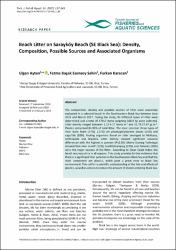Beach litter on Saraykoy beach (SE Black Sea): density, composition, possible sources and associated organisms
Citation
Aytan, Ü., Şahin, B.E. & Karacan, F. (2020). Beach Litter on Saraykoy Beach (SE Black Sea): Density, Composition, Possible Sources and Associated Organisms. Turkish Journal of Fisheries and Aquatic Sciences, 20(2), 137-145. https://doi.org/10.4194/1303-2712-v20_2_06Abstract
The composition, density and possible sources of litter were seasonally evaluated in a selected beach in the Southeastern Black Sea between June 2016 and March 2017. During the study, 84 different types of litter were determined and a total of 17015 items weighing 168.9 kg were collected. Litter density ranged between 1.22-4.17 items.m(-2) and 11.78-37.47 gr.m(-2). Plastics comprised 84-91% of total litter. the most common three types of litter were foam (17%), 2.5-50 cm plastic/polystyrene pieces (15%) and caps/lids (10%). Fouling organisms found on litter belonged to Mollusca, Arthropoda and Bryozoa. Litter density showed significant seasonal differences with the highest in summer (P<0.05). Matrix Scoring Technique showed that river runoff (22%), landfill/dumping (21%) and fisheries (18%) were the major sources of the litter. According to Clean Coast Index, the beach was very dirty in all seasons. This study provides further evidence that there is a significant litter pollution in the Southeastern Black Sea and that the main component are plastics, which pose a great treat to Black Sea environment. This call for a scientific understanding of the fate and effects of plastics, as well as actions to reduce the amount of plastics entering Black Sea.


















